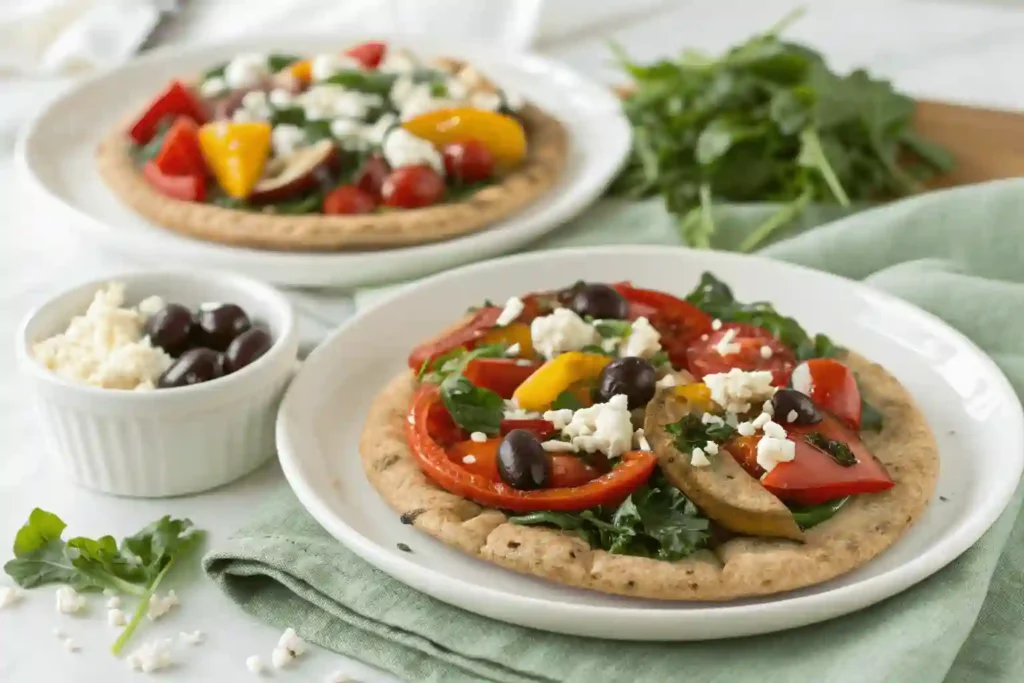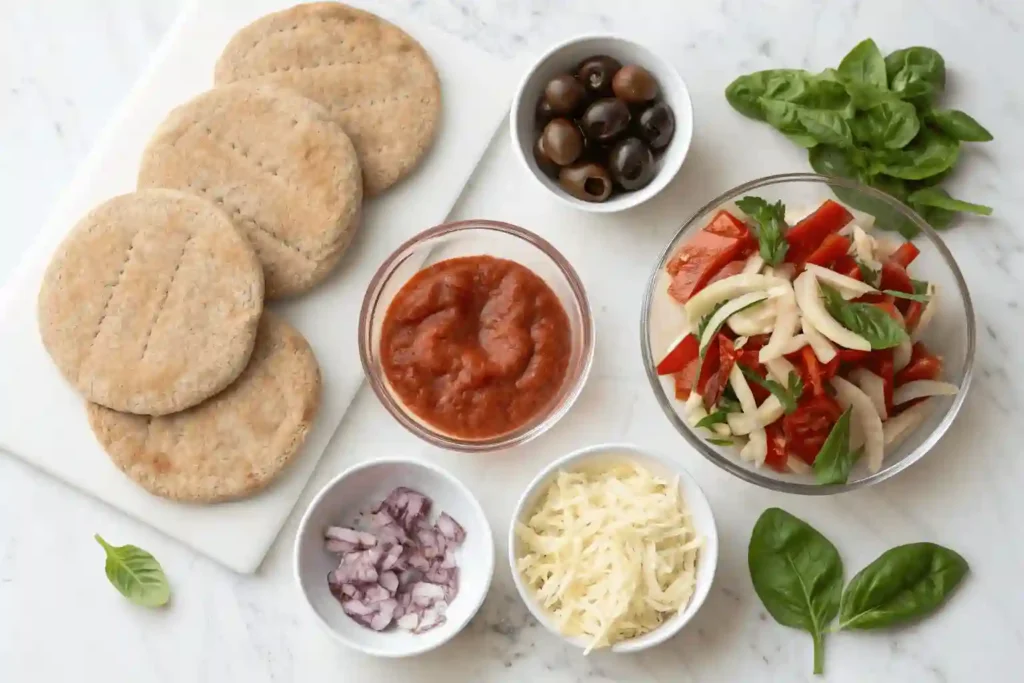- Bang Bang Broccoli Salad (Sweet, Spicy & Ready in 15 Minutes!) – June 13, 2025
- One-Pot Garlic Butter Chicken with Broccoli: A Low-Carb Dream for Diabetics – June 13, 2025
- Avocado Hummus Recipe (Creamy, Blood Sugar–Friendly & Fast) – June 13, 2025
A Flavorful Mediterranean Fix — Without the Blood Sugar Spikes
Let’s be honest — pizza night can feel like enemy territory when you’re watching your carbs. But what if I told you there’s a way to get that crisp-chewy bite, the salty-savory toppings, and that warm-from-the-oven comfort… all while respecting your blood sugar?
This Greek vegetable pita pizzas was born from that very craving. It’s fast (think 20 minutes), layered with fiber-rich toppings, and built on whole-grain pitas that won’t send your glucose on a rollercoaster. Every ingredient has a purpose — from the lycopene-packed tomato sauce to the tangy olives and feta that add flavor without relying on added sugar or heavy fats.
This isn’t just “pizza, but healthy.” It’s pizza reimagined for someone who wants to enjoy life and stay in control of their numbers.
Here’s what you’ll get:
- A step-by-step, no-stress recipe that’s diabetes-conscious
- Built-in portion control without sacrificing satisfaction
- Optional swaps to suit your pantry or personal taste
Ready to bring a little Mediterranean joy to your kitchen — and your plate?

Quick Facts & Ingredients: Your Smart Pizza Base
This isn’t your average pizza — and it doesn’t try to be. It’s faster, lighter, and smarter. Here’s the breakdown:
- Prep Time: 10 minutes
- Cook Time: 8 minutes
- Total Time: 18 minutes
- Servings: 4
- Calories per Serving: ~170
- Carbs per Serving: ~18g
- Fiber per Serving: ~4g
- Protein per Serving: ~9g
- Fat per Serving: ~7g (mostly from healthy fats)
Each pita = one portion. Built-in portion control = blood sugar peace of mind.
Ingredients (Makes 4 Servings)
Base:
- 4 small whole wheat pitas (4-inch diameter) — high in fiber, lower glycemic impact
Sauce & Cheese:
- 1 cup jarred low-sodium pizza sauce — choose one without added sugars
- ¼ cup reduced-fat Italian shredded cheese — melts well, adds creaminess without overload
Veggie Toppings:
- ¼ cup Kalamata olives, sliced — salty punch, heart-healthy fats
- ¼ cup roasted red peppers, thinly sliced — natural sweetness, rich in antioxidants
- ¼ cup marinated artichoke hearts, chopped — fiber-rich, slightly tangy
- 1 shallot, thinly sliced — adds depth without spiking sugar
Finishing Touches:
- 2 oz reduced-fat feta cheese, crumbled — bold flavor, calcium-rich
- ½ cup fresh basil, julienned — herbal brightness, zero carbs
Diabetic Swap Tip: Need lower sodium? Rinse the olives and artichokes under cold water before using.

How to Make Greek Vegetable Pita Pizzas (Step-by-Step)
These come together fast — faster than your glucose monitor syncs sometimes. Follow this routine, and you’ll have a warm, savory, blood-sugar-friendly meal on the table in under 20 minutes.
1. Preheat your oven to 400°F (200°C).
Use the middle rack for even heat. If you want ultra-crispy pitas, place a baking sheet in the oven while it preheats — that hot surface gives the crust a golden edge.
2. Prep your baking sheet.
Line it with parchment paper or lightly spray with cooking oil. Lay out the four whole wheat pitas in a single layer — no overlap. Each pita is its own personal pizza.
3. Sauce it up — but not too much.
Spread about ¼ cup of the low-sodium pizza sauce onto each pita. Tip: Don’t go edge to edge. Leave a ½-inch border so it crisps properly and avoids sogginess.
4. Layer the base cheese and toppings.
Divide the shredded Italian cheese evenly among the pitas (about 1 tablespoon each). Then add your sliced olives, roasted red peppers, chopped artichokes, and thin shallot slices. Keep the toppings light — overloaded pitas don’t crisp up well and may feel heavy.
5. Bake for 7–8 minutes.
You’re aiming for melted cheese and slightly crisped edges. Keep an eye on it at the 6-minute mark — ovens vary, and overbaking dries out the pita.
6. Finish with flair.
Once out of the oven, sprinkle with the crumbled feta and fresh basil. The residual heat will soften them just enough to release flavor without wilting them fully.
Diabetic Smart Tip:
Want more protein to keep blood sugar stable longer? Add grilled chicken breast slices or chickpeas before baking. Just ¼ cup per pizza will do the trick.
Can I make these ahead of time?
Yes — with one caveat.
Assemble everything except the feta and basil. Wrap tightly and refrigerate for up to 24 hours. When ready, bake straight from the fridge, then top fresh. Pitas may need 1–2 extra minutes in the oven when cold.
Tips & Variations for a Diabetic-Friendly Twist
Whether you’re cooking for yourself, a diabetic family member, or someone just trying to eat smarter — flexibility is key. Here’s how to adapt, upgrade, or simplify this recipe while keeping blood sugar levels in check.
Smart Substitutions (Without Sacrificing Flavor)
- Pita Swap: No whole wheat on hand? Try a low-carb tortilla (cut to fit) or a gluten-free flatbread — just check the fiber content and look for ≤15g net carbs per piece.
- Sauce Saver: Can’t find low-sodium pizza sauce? Use crushed tomatoes mixed with dried oregano and garlic powder. Bonus: No added sugar.
- Cheese Choices: Prefer dairy-free? Use a shredded plant-based cheese with low saturated fat. Just double-check for carb content — some vegan cheeses sneak in starch.
Protein-Boosted Topping Ideas (Stabilize Blood Sugar)
- Grilled chicken breast (sliced thin)
- Crumbled turkey sausage (low-fat, no sugar added)
- Canned chickpeas (rinsed, lightly mashed)
- Tofu cubes (marinated and pan-seared)
Adding 10–15g of protein per serving can help slow down carb absorption — and keep you fuller, longer.
Cooking Tips for Better Texture
- Pre-toast the pitas for 2 minutes before adding toppings if you like a crispier base.
- Avoid watery toppings (like raw tomatoes or fresh spinach). If using, dry them well or add post-bake.
- Broil for 1 minute at the end if you want bubbly, browned cheese — just don’t walk away!
What veggies can I swap in and still keep it diabetic-friendly?
Plenty. Try these:
- Zucchini (thin-sliced, pre-roasted)
- Eggplant (cubed and roasted)
- Mushrooms (sautéed to remove moisture)
- Fresh spinach (sautéed or added after baking)
Just make sure any high-water veggie is cooked or blotted dry to avoid soggy pitas — and you’re golden.
Nutrition Breakdown: Why This Pizza Works for Diabetics
This isn’t just a lighter pizza — it’s a strategically balanced one. Each ingredient is selected with blood sugar stability in mind: fiber from whole grains, healthy fats from olives and feta, and just enough protein to steady the curve.
Per Serving (1 individual pita pizza):
- Calories: ~170
- Total Carbohydrates: 18g
- Dietary Fiber: 4g
- Net Carbs: ~14g
- Protein: 9g
- Total Fat: 7g
- Saturated Fat: 2.5g
- Sodium: ~320mg
- Added Sugars: 0g
Glycemic Load Insight:
A net carb count under 15g keeps this meal in a “low glycemic load” category — a smart choice for minimizing post-meal spikes.
Nutrient Highlights:
- Whole Wheat Pita: Slow-digesting carbs, fiber-rich, low glycemic index
- Vegetables: Antioxidant-loaded, low in sugar, add volume without carbs
- Feta & Olives: Satisfying umami + healthy fats = longer satiety window
- Cheese (reduced-fat): Keeps saturated fat in check while delivering flavor
Can I pair this with something and still stay within my carb goal?
Absolutely. Consider pairing it with:
- A side salad with vinaigrette (0–3g net carbs)
- A cup of non-starchy soup like broth-based veggie or lentil
- A small handful of berries (7–10g carbs) if you want a naturally sweet end
Total meal = ~30g net carbs max, which fits many diabetes meal plans — especially if you’re counting carbs or following the Plate Method.

Frequently Asked Questions (FAQs)
Can I eat this if I’m on a low-carb or keto plan?
If you’re strictly keto (under 20–25g net carbs per day), this may be a bit high unless you use a low-carb wrap instead of pita. But for a moderate low-carb or diabetic-friendly plan (40–60g carbs per meal), this fits well — especially paired with a low-carb side.
Can I prep these ahead and store them?
Yes — for up to 2 days.
Assemble the pizzas without baking. Wrap tightly and refrigerate. When ready, bake directly from the fridge at 400°F for 8–10 minutes. Top with basil and feta after baking.
Pro tip: You can also freeze them pre-baked. Reheat at 375°F for 10 minutes straight from frozen.
What if I don’t like feta?
You’re not alone.
Swap in goat cheese, part-skim ricotta (for creaminess), or skip the finishing cheese altogether. The Italian blend underneath will still deliver that gooey satisfaction.
Is this safe for Type 1 diabetics?
Yes — but portion control and carb-counting matter more.
Each pizza has ~18g total carbs (14g net). Adjust your insulin accordingly, and always pair with protein or fiber-rich sides to help buffer absorption.
Final Thoughts: Pizza Night, Reinvented
There’s something deeply comforting about pizza — but for many navigating diabetes, it’s often the first thing that gets cut. This recipe is proof that you don’t have to settle for bland swaps or rigid meal plans. With smart choices and balanced portions, pizza night can absolutely stay on the menu.
You’ve got flavor. You’ve got texture. And most importantly, you’ve got control — over ingredients, portions, and how your body responds.
Try this Greek Vegetable Pita Pizza once, and it just might become your go-to weeknight rescue. And if you discover your own variation that works beautifully with your numbers? Share it. That’s how we build better plates — and better routines — together.


Leave a Reply